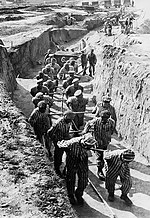
Back Konzentrationslager ALS معسكرات الاعتقال النازية Arabic معسكرات النازى ARZ নাজী নিৰ্যাতন শিবিৰ Assamese Nasist həbs düşərgələri Azerbaijani Нацистик Германияның концентрацион лагерҙары Bashkir Kampung perangkèngan Natsi BEW নাৎসি বন্দীশিবির Bengali/Bangla Kamp-bac'h nazi Breton Camp de concentració nazi Catalan
| Nazi concentration camps | ||||
|---|---|---|---|---|
 | ||||
| Main camps | ||||
Organization
|
||||
| Topics | ||||
| Personnel | ||||
Prisoners
|
From 1933 to 1945, Nazi Germany operated more than a thousand concentration camps (German: Konzentrationslager[a]), including subcamps[b] on its own territory and in parts of German-occupied Europe.
The first camps were established in March 1933 immediately after Adolf Hitler became Chancellor of Germany. Following the 1934 purge of the SA, the concentration camps were run exclusively by the SS via the Concentration Camps Inspectorate and later the SS Main Economic and Administrative Office. Initially, most prisoners were members of the Communist Party of Germany, but as time went on different groups were arrested, including "habitual criminals", "asocials", and Jews. After the beginning of World War II, people from German-occupied Europe were imprisoned in the concentration camps. About 1.65 million people were registered prisoners in the camps, of whom about a million died during their imprisonment.[c] Most of the fatalities occurred during the second half of World War II, including at least a third of the 700,000 prisoners who were registered as of January 1945. Following Allied military victories, the camps were gradually liberated in 1944 and 1945, although hundreds of thousands of prisoners died in the death marches.
Museums commemorating the victims of the Nazi regime have been established at many of the former camps and the Nazi concentration camp system has become a universal symbol of violence and terror.
Cite error: There are <ref group=lower-alpha> tags or {{efn}} templates on this page, but the references will not show without a {{reflist|group=lower-alpha}} template or {{notelist}} template (see the help page).
- ^ Stone 2017, p. 50.
- ^ Orth 2009a, p. 194.
- ^ Goeschel & Wachsmann 2010, p. 515.
